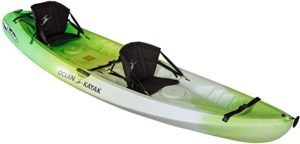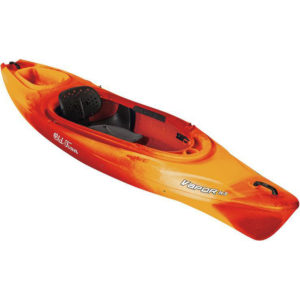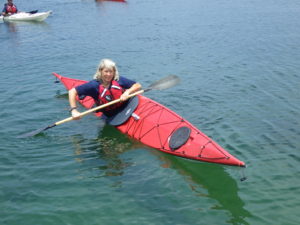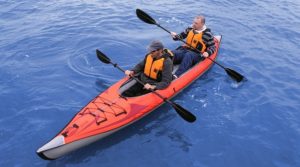There are five main types of kayaks readily available in local stores, online, or on craigslist. Each has strengths and weaknesses, and some are simply dangerous on the open ocean without proper training. SUPs (stand up paddleboards) are also becoming very common. If you are actively surfing an SUP and less than 100 yards from shore, an SUP is regulated like a surf board. If you are more than 100 yards from shore, an SUP is regulated like a kayak.
 Sit-on-top kayaks (SOTs): These are a hollow, (mostly) sealed shell of plastic that the paddler literally sits on top of in a seat well. The seat well and any other indentations will have scupper (drain) holes so that any water that comes over the top will drain out. This is important, because even a small amount of water can decrease the stability of a kayak significantly. While SOTs are meant to be sealed, water always seems to find its way through the pin-prick holes and gaps that are inevitable in mass production. A drain hole will be installed so that this water can be drained when it accumulates sufficiently. Forgetting to tighten the drain plug, or a bigger hole or gap (often caused by wear) can cause dangerous levels of water and destabilization to the point that it’s impossible to paddle. With proper attention to the care of your SOT kayak, these are by far the safest type on the open ocean without the significant training and skill required to handle sea kayaks.
Sit-on-top kayaks (SOTs): These are a hollow, (mostly) sealed shell of plastic that the paddler literally sits on top of in a seat well. The seat well and any other indentations will have scupper (drain) holes so that any water that comes over the top will drain out. This is important, because even a small amount of water can decrease the stability of a kayak significantly. While SOTs are meant to be sealed, water always seems to find its way through the pin-prick holes and gaps that are inevitable in mass production. A drain hole will be installed so that this water can be drained when it accumulates sufficiently. Forgetting to tighten the drain plug, or a bigger hole or gap (often caused by wear) can cause dangerous levels of water and destabilization to the point that it’s impossible to paddle. With proper attention to the care of your SOT kayak, these are by far the safest type on the open ocean without the significant training and skill required to handle sea kayaks.
 Recreational Kayaks: These are popular among beginners because they have a very large seating or “cockpit” area, recessed down into a hollow open shell. Recreational kayaks are mass-produced much like plastic garbage barrels and have become incredibly cheap. Unfortunately, their design makes them extremely dangerous in open ocean conditions and in waves where they can take on water to the point of sinking. Even if they don’t sink, deep-water re-entry after a capsize is virtually impossible without outside help, making them very poorly suited for La Jolla except on the calmest days and close to shore within sight of the lifeguard towers.
Recreational Kayaks: These are popular among beginners because they have a very large seating or “cockpit” area, recessed down into a hollow open shell. Recreational kayaks are mass-produced much like plastic garbage barrels and have become incredibly cheap. Unfortunately, their design makes them extremely dangerous in open ocean conditions and in waves where they can take on water to the point of sinking. Even if they don’t sink, deep-water re-entry after a capsize is virtually impossible without outside help, making them very poorly suited for La Jolla except on the calmest days and close to shore within sight of the lifeguard towers.
 Sea Kayaks: Sea kayaks have a recessed cockpit like recreational kayaks, but it’s much smaller. They also have watertight bulkheads fore and aft to ensure that most of the kayak cannot fill with water. This allows for deep-water re-entry in the event of a capsize. Sea kayaks are also much more narrow than recreational kayaks and this allows a paddler to fit a “spray skirt” over the cockpit area to keep water out in the roughest conditions. With a properly trained paddler, a sea kayak can handle much of what the ocean can dish out. With an untrained paddler, a sea kayak can be just as dangerous as a recreational kayak. It’s essential to learn and practice some basic skills in calm water like exiting in the event of a capsize (panic can keep a paddler from releasing their spray skirt), and deep water re-entry.
Sea Kayaks: Sea kayaks have a recessed cockpit like recreational kayaks, but it’s much smaller. They also have watertight bulkheads fore and aft to ensure that most of the kayak cannot fill with water. This allows for deep-water re-entry in the event of a capsize. Sea kayaks are also much more narrow than recreational kayaks and this allows a paddler to fit a “spray skirt” over the cockpit area to keep water out in the roughest conditions. With a properly trained paddler, a sea kayak can handle much of what the ocean can dish out. With an untrained paddler, a sea kayak can be just as dangerous as a recreational kayak. It’s essential to learn and practice some basic skills in calm water like exiting in the event of a capsize (panic can keep a paddler from releasing their spray skirt), and deep water re-entry.
 Inflatable kayaks: These range from pool toys, to top-of-the-line expedition worthy kayaks. The more expensive, the better suited to rougher conditions and waves they will be, as well as more resistant to tears and abrasions. Any inflatable that you use on the open ocean should have multiple air chambers in the event that one or more fails. They should be properly inflated to manufacturers specifications.
Inflatable kayaks: These range from pool toys, to top-of-the-line expedition worthy kayaks. The more expensive, the better suited to rougher conditions and waves they will be, as well as more resistant to tears and abrasions. Any inflatable that you use on the open ocean should have multiple air chambers in the event that one or more fails. They should be properly inflated to manufacturers specifications.
Whitewater kayaks: These are less common but sometimes appear on craigslist for under $200. An attractive price, but a very dangerous kayak if you don’t know how to use it. Whitewater kayaks have small, recessed cockpit areas like sea kayaks do, but they are much shorter and don’t have watertight bulkheads. Instead, the hollow space is intended to be filled with specially designed airbladders that displace most of the water in the event of a capsize. Even with these airbladders, a deep water re-entry is impossible without a lot of help. River kayakers either learn to roll these kayaks back right-side-up when they flip over, or simply swim to shore.